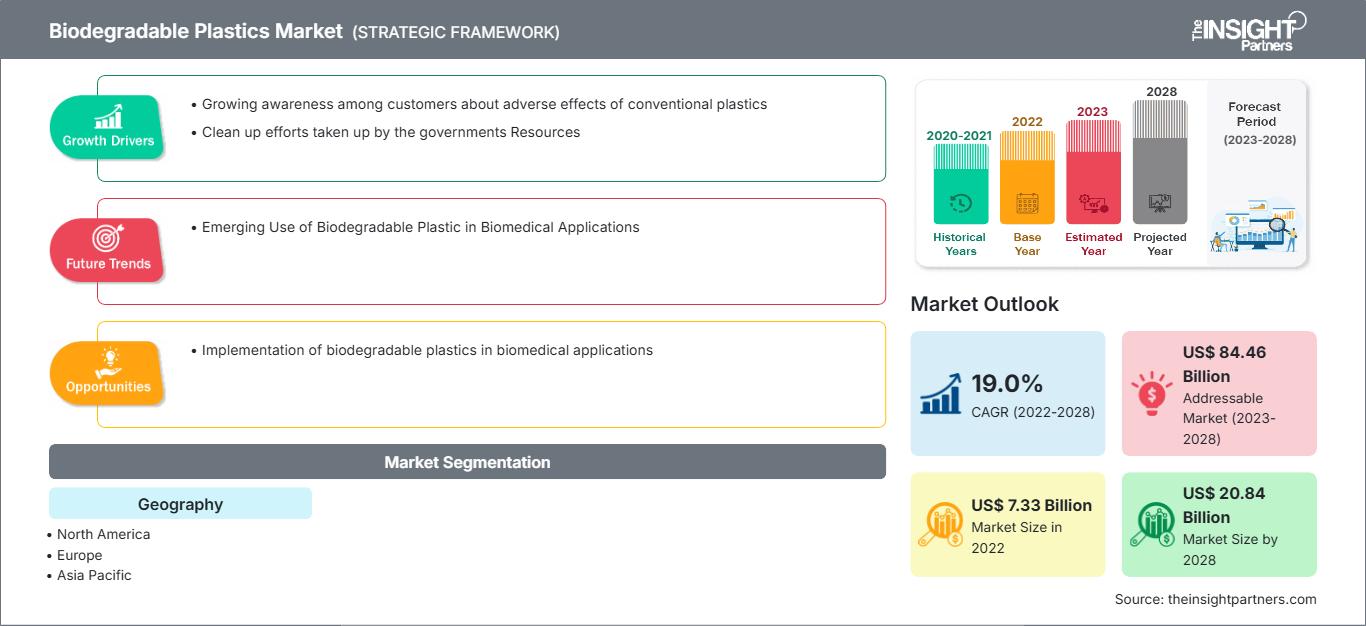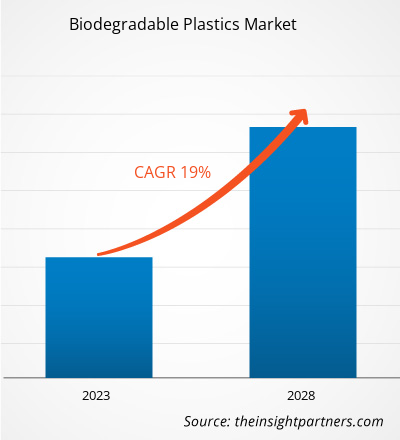[Forschungsbericht] Der Markt für biologisch abbaubare Kunststoffe soll von 7.331,11 Millionen US-Dollar im Jahr 2022 auf 20.840,29 Millionen US-Dollar im Jahr 2028 wachsen; von 2022 bis 2028 wird ein durchschnittliches jährliches Wachstum von 19,0 % erwartet.
MARKTANALYSE
Biologisch abbaubarer Kunststoff kann in der Umwelt durch lebende Organismen, meist Mikroben, auf natürliche Weise zu Wasser, Kohlendioxid und Biomasse zersetzt werden. Seine Synthese erfolgt aus nachwachsenden Rohstoffen, Mikroorganismen und Petrochemikalien. Biologisch abbaubare Kunststoffe mineralisieren in einer kontrollierten Abfallwirtschaftsumgebung und stellen eine effektive und umweltfreundliche Alternative zu synthetischen Polymeren dar. Regierungen und Hersteller weltweit bemühen sich, das Recycling und Upcycling von Kunststoffabfällen effizienter zu gestalten. Das wachsende Bewusstsein der Kunden für die negativen Auswirkungen herkömmlicher Kunststoffe dürfte die Produktnachfrage ankurbeln.
WACHSTUMSTREIBER UND HERAUSFORDERUNGEN
Die Kunden in Industrie- und Entwicklungsländern sind über die negativen Auswirkungen herkömmlicher Kunststoffe auf ihren Lebensstil und die Umwelt aufgeklärt. Daher verlangen sie umweltfreundlichere Produkte, was zu einer geringeren Nutzung von Rohöl und Erdgas und damit zu einer Verringerung des CO2-Fußabdrucks führt. Biologisch abbaubarer Kunststoff ist ein Ersatz für fast alle herkömmlichen Kunststoffe und wird in einer Vielzahl von Anwendungen eingesetzt. Diese Kunststoffe bieten innovative Alternativen mit verbesserten Eigenschaften sowie der besonderen Fähigkeit, Emissionen zu verringern und gleichzeitig dieselben Qualitäten und Funktionen wie herkömmliche Kunststoffe bereitzustellen. Die biologisch abbaubaren Kunststoffe werden aus erneuerbaren Ressourcen und fossilen Rohstoffen wie Celluloseester, PLA, PHA, Stärkederivaten und Copolyestern synthetisiert. Verschiedene Organisationen engagieren sich für einen Wandel im Umgang mit Kunststoffen. Dies geschieht durch strategische Planung, Kommunikation, Verbraucheraufklärungskampagnen, Dokumentarfilme, Aufklärung, Reinigungskampagnen, Sensibilisierung der Wirtschaft, wissenschaftliche Forschung, unternehmerische Innovation, Gesetzgebung und Nachhaltigkeit. Das Hauptziel besteht darin, die Verbraucher über die Plastikverschmutzung aufzuklären und so die Entwicklung nachhaltigerer Lösungen zu fördern. Zudem werden mehr Menschen und Unternehmen dazu befähigt, Maßnahmen gegen die Plastikverschmutzung zu ergreifen. Die veränderte Verbrauchernachfrage nach Umweltbewusstsein, praktischen Verpackungen und nachhaltigen Kunststoffproduktionssystemen fördert daher das Wachstum des Marktes für biologisch abbaubare Kunststoffe.
Passen Sie diesen Bericht Ihren Anforderungen an
Sie erhalten kostenlos Anpassungen an jedem Bericht, einschließlich Teilen dieses Berichts oder einer Analyse auf Länderebene, eines Excel-Datenpakets sowie tolle Angebote und Rabatte für Start-ups und Universitäten.
Markt für biologisch abbaubare Kunststoffe: Strategische Einblicke

-
Holen Sie sich die wichtigsten Markttrends aus diesem Bericht.Dieses KOSTENLOSE Beispiel umfasst Datenanalysen, die von Markttrends bis hin zu Schätzungen und Prognosen reichen.
SEGMENTIERUNG UND UMFANG DES BERICHTS
Die „Globale Marktanalyse für biologisch abbaubare Kunststoffe bis 2030“ ist eine spezialisierte und detaillierte Studie mit Schwerpunkt auf globalen Markttrends und Wachstumschancen. Der Bericht soll einen Überblick über den globalen Markt mit detaillierter Marktsegmentierung nach Typ, Endverbraucher und Geografie geben. Der globale Markt für biologisch abbaubare Kunststoffe hat in der jüngsten Vergangenheit ein hohes Wachstum erlebt und dieser Trend dürfte sich im Prognosezeitraum fortsetzen. Der Bericht liefert wichtige Statistiken zum weltweiten Verbrauch biologisch abbaubarer Kunststoffe sowie zur Nachfrage in wichtigen Regionen und Ländern. Darüber hinaus bietet der Bericht eine qualitative Bewertung verschiedener Faktoren, die die Marktleistung für biologisch abbaubare Kunststoffe in wichtigen Regionen und Ländern beeinflussen. Der Bericht enthält auch eine umfassende Analyse der führenden Akteure auf dem Markt für biologisch abbaubare Kunststoffe und ihrer wichtigsten strategischen Entwicklungen. Es sind auch mehrere Analysen der Marktdynamik enthalten, um die wichtigsten Antriebsfaktoren, Markttrends und lukrativen Gelegenheiten zu identifizieren, die wiederum bei der Identifizierung der wichtigsten Einnahmequellen helfen.
Darüber hinaus bieten die Ökosystemanalyse und die Fünf-Kräfte-Analyse von Porter eine 360-Grad-Ansicht des globalen Marktes für biologisch abbaubare Kunststoffe, die dabei hilft, die gesamte Lieferkette und die verschiedenen Faktoren zu verstehen, die das Marktwachstum beeinflussen.
SEGMENTANALYSE
Der globale Markt für biologisch abbaubare Kunststoffe ist nach Typ und Endverbraucher segmentiert. Nach Typ wird der Markt für biologisch abbaubare Kunststoffe in PLA, PHA, Stärkemischungen, PBS, PBAT und andere segmentiert. Nach Endverbraucher wird der Markt in Verpackungen und Beutel, Landwirtschaft und Gartenbau, Konsumgüter und andere unterteilt. Nach Typ machen Stärkemischungen einen erheblichen Anteil aus. Stärke ist ein natürlich vorkommendes Polymer, das in Pflanzen wie Mais, Reis und Kartoffeln in Form wasserunlöslicher Körnchen vorkommt. Aufgrund der mangelnden Verfügbarkeit herkömmlicher filmbildender Harze gewinnt Stärke als Rohstoff für die Folienherstellung zunehmend an Bedeutung. Polyhydroxyalkanoate (PHA) gehören zur Familie der natürlich vorkommenden Polymere. Aufgrund ihrer Biokompatibilität hat PHA einen wichtigen Platz in der Medizin gefunden. Es ist gut UV-beständig, jedoch schlecht säure- und basenbeständig und zudem in Chloroform und anderen chlorierten Kohlenwasserstoffen löslich. PBS zersetzt sich bekanntermaßen auf natürliche Weise in Wasser und Kohlendioxid. PBS wird häufig zur Herstellung von Verpackungsfolien und -schachteln sowie in Kosmetikverpackungen verwendet. Gemessen am Endverbraucher macht der Bereich Verpackungen und Beutel den größten Anteil aus. Biologisch abbaubare Kunststoffe haben aufgrund ihrer Eigenschaften wie hoher Zugfestigkeit und einfacher Handhabung im Vergleich zu herkömmlichen Kunststoffen einen wichtigen Platz im Verpackungs- und Beutelsektor eingenommen. Die steigende Nachfrage nach umweltfreundlichen Lebensmittelverpackungen lenkt den Fokus wichtiger Polymerhersteller und Verpackungsunternehmen auf abbaubare Kunststoffe. Nachhaltige Kunststoffe werden im Alltag auch bei der Herstellung von Konsumgütern wie Spielzeug, Kämmen, Werkzeuggriffen und anderen Produkten eingesetzt. PLA- und PHA-Polymere finden breite Anwendung in der Spielzeugproduktion. Italeri, einer der führenden italienischen Spielzeughersteller, setzt PHA- und PLA-Kunststoffe bereits bei der Spielzeugproduktion ein.
REGIONALE ANALYSE
Der Bericht bietet einen detaillierten Überblick über den globalen Markt für biologisch abbaubare Kunststoffe in fünf Hauptregionen: Nordamerika, Europa, Asien-Pazifik (APAC), Naher Osten und Afrika (MEA) sowie Süd- und Mittelamerika. Europa hatte einen erheblichen Marktanteil, der im Jahr 2022 auf über 2.600 Millionen US-Dollar geschätzt wurde. Diese Dominanz ist auf das zunehmende Umweltbewusstsein der Verbraucher und die zunehmende Verbreitung biologisch abbaubarer Kunststoffe aufgrund ihrer Umweltfreundlichkeit zurückzuführen. Zudem werden strenge Vorschriften für Einweg-Plastikbänder in Verbindung mit Regierungsinitiativen zur Einführung recycelbarer Verpackungen das Wachstum der regionalen Branche vorantreiben. In Nordamerika wird ebenfalls ein beträchtliches Wachstum im Wert von etwa 4.900 Millionen US-Dollar im Jahr 2028 erwartet, was auf das zunehmende Bewusstsein der Menschen für umweltfreundliche Produkte zurückzuführen ist. Das wachsende Bewusstsein für die globale Erwärmung und die Plastikverschmutzung veranlasst Verbraucher, sich für umweltfreundliche Verpackungen zu entscheiden. Der asiatisch-pazifische Raum verzeichnet ein beträchtliches Wachstum mit einer durchschnittlichen jährlichen Wachstumsrate von über 20,5 %. Die steigende Zahl von Verboten herkömmlicher Kunststoffe erweist sich als Haupttreiber für das Wachstum dieses Marktes. Darüber hinaus werden die wachsende Nachfrage nach flexiblen Verpackungen aus der Konsumgüterindustrie und die Einführung verschiedener technologischer Innovationen im Verpackungsbereich das regionale Wachstum ankurbeln.
BRANCHENENTWICKLUNGEN UND ZUKÜNFTIGE CHANCEN
Der Bericht bietet einen detaillierten Überblick über den globalen Markt für biologisch abbaubare Kunststoffe im Hinblick auf fünf Hauptregionen, nämlich: Nordamerika, Europa, Asien-Pazifik (APAC), Naher Osten und Afrika (MEA) sowie Süd- und Mittelamerika.
Im Jahr 2022 kündigte Kaneka an, 15 Milliarden japanische Yen zu investieren, um seine Produktionskapazität für KANEKA Biodegradable Polymer Green Planet in Japan zu erhöhen. Ziel der Investition ist es, die Produktionskapazität von 5.000 Tonnen auf rund 20.000 Tonnen pro Jahr zu steigern. Der Betrieb soll im Januar 2024 beginnen.
Im Jahr 2021 kündigte die in Südkorea ansässige SK Group an, eine strategische Partnerschaft mit dem lokalen Handelsunternehmen LX International und dem Lebensmittelunternehmen Daesang einzugehen, um ein Joint Venture (JV) zur Herstellung von PBAT mit einer Investition von 151,3 Millionen US-Dollar zu gründen.
Biologisch abbaubare Kunststoffe
Regionale Einblicke in den Markt für biologisch abbaubare KunststoffeDie Analysten von The Insight Partners haben die regionalen Trends und Faktoren, die den Markt für biologisch abbaubare Kunststoffe im Prognosezeitraum beeinflussen, ausführlich erläutert. In diesem Abschnitt werden auch die Marktsegmente und die geografische Lage für biologisch abbaubare Kunststoffe in Nordamerika, Europa, im asiatisch-pazifischen Raum, im Nahen Osten und Afrika sowie in Süd- und Mittelamerika erörtert.
Umfang des Marktberichts über biologisch abbaubare Kunststoffe
| Berichtsattribut | Einzelheiten |
|---|---|
| Marktgröße in 2022 | US$ 7.33 Billion |
| Marktgröße nach 2028 | US$ 20.84 Billion |
| Globale CAGR (2022 - 2028) | 19.0% |
| Historische Daten | 2020-2021 |
| Prognosezeitraum | 2023-2028 |
| Abgedeckte Segmente |
By Geographie
|
| Abgedeckte Regionen und Länder |
Nordamerika
|
| Marktführer und wichtige Unternehmensprofile |
|
Dichte der Marktteilnehmer für biologisch abbaubare Kunststoffe: Verständnis ihrer Auswirkungen auf die Geschäftsdynamik
Der Markt für biologisch abbaubare Kunststoffe wächst rasant. Die steigende Nachfrage der Endverbraucher ist auf Faktoren wie veränderte Verbraucherpräferenzen, technologische Fortschritte und ein stärkeres Bewusstsein für die Produktvorteile zurückzuführen. Mit der steigenden Nachfrage erweitern Unternehmen ihr Angebot, entwickeln Innovationen, um den Bedürfnissen der Verbraucher gerecht zu werden, und nutzen neue Trends, was das Marktwachstum weiter ankurbelt.

- Holen Sie sich die Markt für biologisch abbaubare Kunststoffe Übersicht der wichtigsten Akteure
AUSWIRKUNGEN VON COVID/AUSWIRKUNGEN DES GEOPOLITISCHEN SZENARIOS/AUSWIRKUNGEN EINER REZESSION
Der Bericht bietet einen detaillierten Überblick über den globalen Markt für biologisch abbaubare Kunststoffe in Bezug auf fünf Hauptregionen, nämlich Nordamerika, Europa, Asien-Pazifik (APAC), Naher Osten und Afrika (MEA) sowie Süd- und Mittelamerika. Branchen wie Verpackung und Taschen, Landwirtschaft und Gartenbau, Konsumgüter und die Automobilindustrie sind die Hauptabnehmer von biologisch abbaubaren Kunststoffen. Im Jahr 2020 mussten diese Branchen ihre Betriebsabläufe aufgrund von Störungen in der Wertschöpfungskette drosseln, die durch die Schließung nationaler und internationaler Grenzen verursacht wurden. Darüber hinaus beeinträchtigten von verschiedenen Ländern verhängte Lockdowns die Fähigkeit der Branchen im selben Jahr, ihre Lagerbestände aufrechtzuerhalten. Die Pandemie richtete auch in der Automobil- und Konsumgüterindustrie verheerende Schäden an. Der Mangel an Arbeitskräften führte zu einer Verlangsamung der Produktion und des Vertriebs biologisch abbaubarer Kunststoffe. Darüber hinaus reduzierten staatliche Beschränkungen und andere COVID-19-Vorkehrungen die Produktionskapazitäten der Hersteller biologisch abbaubarer Kunststoffe in der Wertschöpfungskette. Im Jahr 2021 begann sich der globale Markt von den Verlusten des Jahres 2020 zu erholen, da die Regierungen verschiedener Länder Lockerungen der sozialen Beschränkungen ankündigten. Darüber hinaus führten zunehmende staatliche Verbote von Einwegplastik und der Ausbau der Produktionskapazitäten in der Landwirtschaft sowie der Lebensmittel- und Getränkeverpackungsindustrie in verschiedenen Regionen der Welt zu einem Anstieg der Nachfrage nach biologisch abbaubaren Kunststoffen im Jahr 2021.
WETTBEWERBSLANDSCHAFT UND WICHTIGE UNTERNEHMEN
Zu den wichtigsten Akteuren auf dem Markt für biologisch abbaubare Kunststoffe gehören unter anderem BASF SE, FKuR Kunststoff GmbH, Green Dot Bioplastics Inc, Novamont SpA, Kingfa Science and Technology Co Ltd, NatureWorks LLC, Mitsubishi Chemical Holdings Corp, Plantic Technologies Ltd, TotalEnergies Corbion BV und API SpA.
- Historische Analyse (2 Jahre), Basisjahr, Prognose (7 Jahre) mit CAGR
- PEST- und SWOT-Analyse
- Marktgröße Wert/Volumen – Global, Regional, Land
- Branchen- und Wettbewerbslandschaft
- Excel-Datensatz
Aktuelle Berichte
Verwandte Berichte
Erfahrungsberichte
Grund zum Kauf
- Fundierte Entscheidungsfindung
- Marktdynamik verstehen
- Wettbewerbsanalyse
- Kundeneinblicke
- Marktprognosen
- Risikominimierung
- Strategische Planung
- Investitionsbegründung
- Identifizierung neuer Märkte
- Verbesserung von Marketingstrategien
- Steigerung der Betriebseffizienz
- Anpassung an regulatorische Trends






















 Kostenlose Probe anfordern für - Markt für biologisch abbaubare Kunststoffe
Kostenlose Probe anfordern für - Markt für biologisch abbaubare Kunststoffe